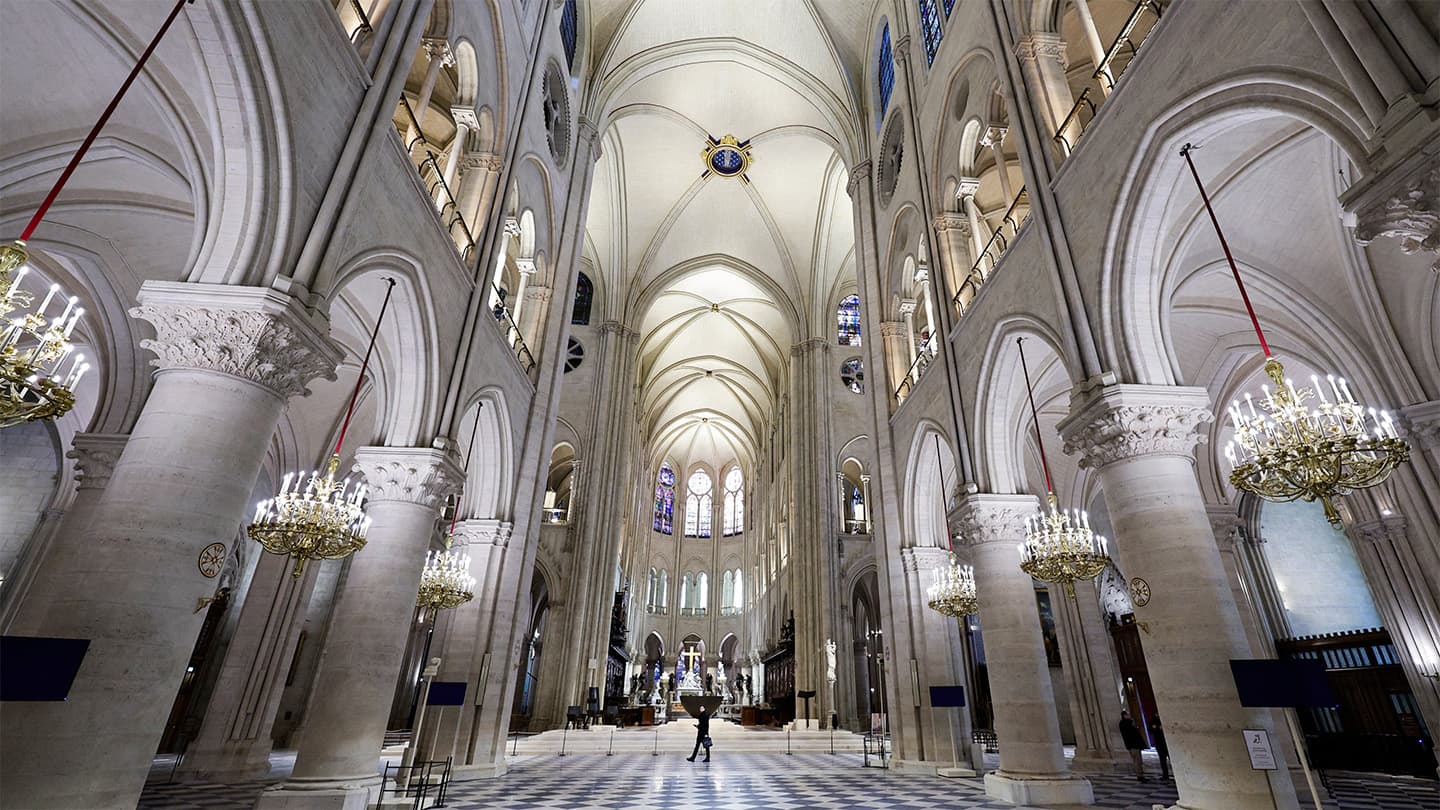Notre Dame is reopening. What does that mean for its acoustics?

Notre Dame is back. And so are its acoustics.
The Paris cathedral, which burned dramatically in a fire in 2019, is reopening to the public on December 8. In the aftermath of the fire, acoustics researcher Brian Katz has been studying the sonic qualities of the cathedral, such as the echoes and reverberations created by the space, both after the restoration and in different eras of the cathedral’s centuries-long history (SN: 1/12/20).
Before the fire, Notre Dame was reverberant, meaning that noises would hang in the air for seconds at a time before dying out, due to sound waves bouncing off the walls, floor and other surfaces inside the massive space. That reverberance was quashed by the fire, which left holes in the vaulted ceiling and debris and ash littering the floor. Now, after repairs to the structure and cleaning to remove toxic lead and other dust released in the fire, the cathedral is closer to its previous self. But even seemingly minor changes to a space, like wall hangings, carpeting or furniture, can alter its acoustics.
Science News spoke to Katz, of CNRS and Sorbonne University in Paris, about his work and what he expects the revitalized cathedral to sound like. This interview has been edited for length and clarity.
SN: What are the acoustics of Notre Dame like now?
Katz: We were there at the end of September to do some progress measurements. There was a lot of construction work still going on. Especially seeing how much it’s been cleaned up since then, we’re very much hoping to get in there in the next couple weeks to do some current state-of-the-situation measurements.
The feedback from the few people who have been in there [more recently] is, “Wow, it’s pretty reverberant in there.” I think we all expect it to be more reverberant [compared to before the fire] because it’s clean and refinished. Every surface was sprayed with latex [that was later peeled off] which sucked out and absorbed the lead from the pores in the stone. Well, it also sucked out all the other dust and everything, so it’s exceptionally clean. All that residual absorption that comes from dust and dirt over the years is gone, so it should be a very vibrant sounding place.
SN: What are the criteria for good acoustics in a space like Notre Dame?
Katz: Regarding sermons, they have a whole new sound system that’s been modernized. And the sound system is really designed to minimize the amount of sound energy that’s sent into the reverberant space and really focus on the audience. So that should really help intelligibility even in a reverberant space.
[For performers not covered by that sound system] it’s mostly a question of the musical style and what is the appropriate reverberation for what they want to play. I’d be really excited to see something that [allows] variable acoustics, a way of rolling tapestries in and out so they can say: We want a more reverberant space or a more subdued space while keeping with the aesthetic. I think that would be the ideal.SN: How were the acoustics considered during the renovation?
Katz: The moment that the decision was made to restore the cathedral as it was before the fire, you didn’t have to decide, “What’s the impact [on the acoustics] if we put a limestone arch here?” because there was one there before. Before that decision was made, there was the question, “What if we make that limestone arch out of glass?” or “What if we really change things?”
So already that removes a lot of the guesswork, and now it’s more the impact of the smaller things like the carpet and the tapestries. Once it gets handed back to the cathedral and starts actually being used, then it’s more fine-tuning, rather than great panics of “Oh my God, what are you doing?”
SN: How does it feel to have Notre Dame finally reopening?
Katz: It really makes me remember the very first time we went in, which was I think two months after the fire, so really quite soon, just when they had started securing the netting and really [doing] some cleaning. And I think we were all of 10 people in Notre Dame at that time, and the solitude and the quietness and the darkness and the smell of the fire was still really omnipresent.
And now to see the pictures of the inside where everything is bright and clean and intact and all of the detail that they’ve added, it’s really amazing, I’m really looking forward to being able to go in.
An animated film by Katz and colleagues, celebrating the history of Notre Dame’s acoustics, premieres on January 24, as part of UNESCO’s Week of Sound. In the film, titled Vaulted Harmonies, music from various historical periods is reproduced as it would have sounded in the cathedral of that era.
Katz and colleagues’ audio guide, Notre-Dame Whispers, available on iOS and Android devices, takes listeners around the exterior of Notre Dame, recounting sounds of cathedral’s past.
